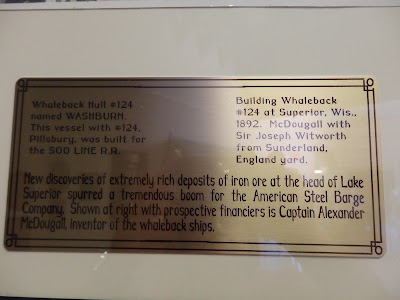 |
| Stern of shop has the superstructure for the housing of the crew. |
 |
| I thought it was interesting how the sides were almost vertical for some of there height. This is ship is buried 10' into the ground. |
 |
| You'll have to click on the photo to enlarge it for reading. |
 |
| The history of the SS Meteor. The ship had three different names during its working years. |
 |
| A flat deck was added so the ship could carry cars. |
 |
| Information on more of the other whalebacks. |
 |
| The SS Christopher Columbus was decked out for the 1893 World's Fair. |
 |
| Lloyd's Register load line on the SS Meteor. The Lloyd's Register Group rated ships on their hull construction. |
 |
| The shop had many winches for lines but the ones just in front of the superstructure could also be used to steer the ship in case the rudder broke. |
 |
| The winch lines would be attached to the pulleys on the plate that stuck up on the side of the ship. |
 |
| The raised structure on the top of the ship was added when it started carrying oil. This was the area that allowed for the expansion of the oil when temperatures raised. |
 |
| As noted in the photo earlier in this post, the ships piping was removed from the ship when it was made into a museum. |
 |
| These were the fire nozzles to spray down the ship in case of a fire. |
 |
| The mast had different lights to indicate if it was moving and if so, what direction. |
 |
| The stern of the ship held the lifeboats, air scoops, stack, water and fuel tanks. |
 |
| The two tanks up front held drinking water and the two rear kerosene. |
 |
| View to the west from the deck. |
 |
| Duluth, MN to the west. |
 |
| View to the north. |
 |
| Navigation deck. . |
 |
| The tall chair was only for the captain |
 |
| The sideways "C" hanging from the ceiling was the floodlight that could be aimed and latched into any position. |
 |
| This shop had lots of equipment added through the years due to advances in technology. |
 |
| The cabin had this heat register. No regulation of the heat - just on or off. |
 |
| This is the whistle pull that went to the engine room so the crewmembers could regulate the engine in accordance to the captain's wishes. |
 |
| Top of the gyro compass |
 |
| Inside the radio telephone cabinet. |
 |
| Next we went down some steep stairs to the captain's quarters. Don't know why he needed two beds. |
 |
| Of course he was the only one with a private bath. |
 |
| Down another steep set of steps we went to the officer's deck. |
 |
| Above each door was the title of the people that occupied the cabin. I failed to take photos of that so I don't know for sure which officers occupied each cabin. |
 |
| Believe it or not, the white rod in the center of the hallway was the rudder control. Yes that skinny rod controlled the position of the ship. |
 |
| Captain and officer's dining room. |
 |
| Tilt indicator |
 |
| Pictures of the galley |
 |
| Dishes were washed with seawater. |
 |
| Crew's dining and recreation room |
 |
| Don't those seats look comfy? |
 |
| Food scraps were sent down this hatch to be deposited in the lake. |
 |
| Crew's quarters didn't look that tight. |
 |
| Crew members were quartered by the hours they worked. |
 |
| Water fountains were supplied by the water tanks on the deck. |
 |
| The workings of the rudder control. |
 |
| Engine room photos didn't come out good but the engines were oversized for the size of the ship because the ships also pulled barges. The engines were at least three decks tall. |
 |
| Different oils were used in the engine for different conditions. |

















































No comments:
Post a Comment